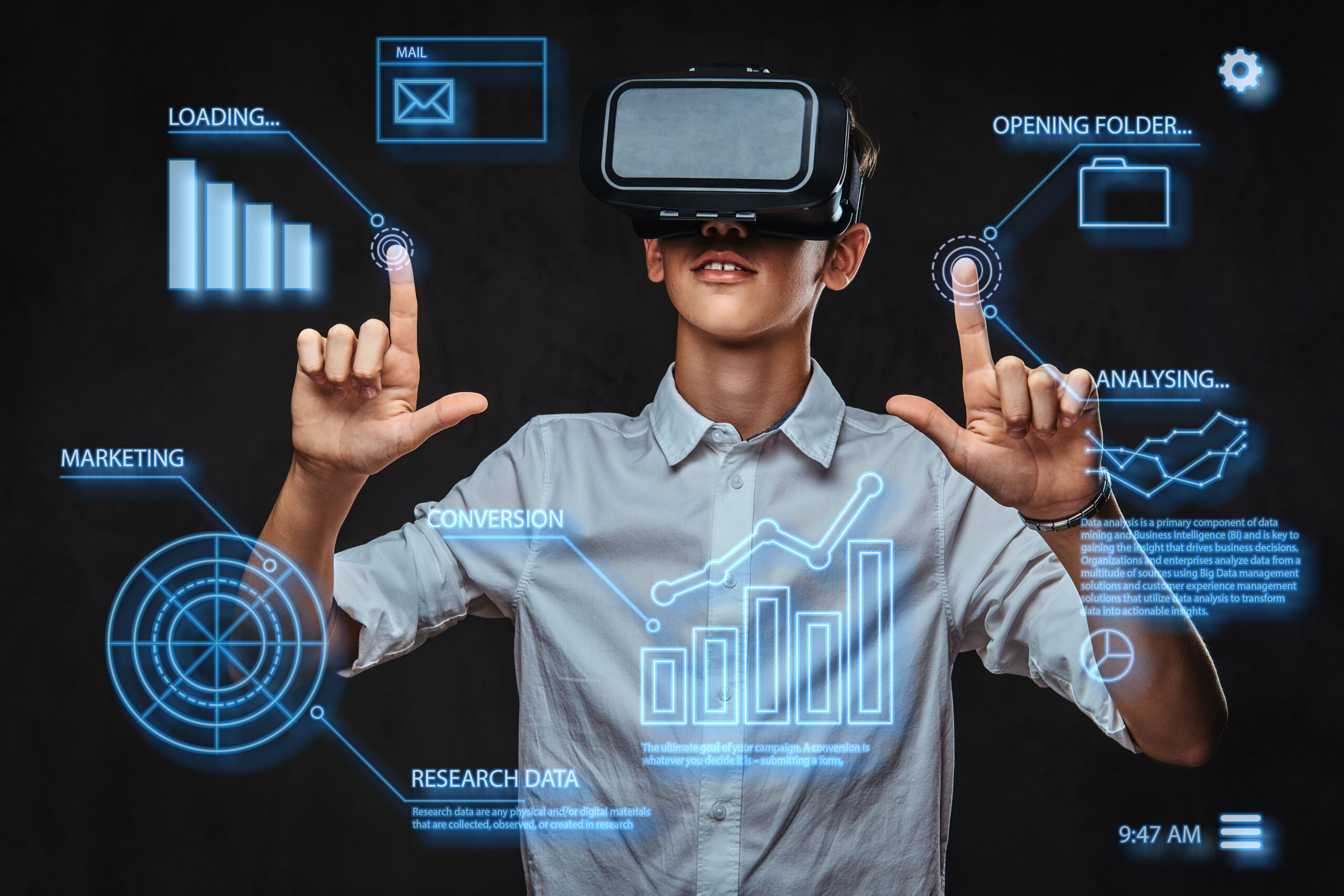- Introduction
Virtual reality and augmented reality have captivated the imaginations of both consumers and professionals alike. These technologies transport users into virtual worlds or enhance their real-world environments with digital overlays, creating immersive and interactive experiences. In this article, we will explore the future of VR and AR, including the scope of augmented reality and the innovations shaping these technologies.
- Understanding Virtual Reality (VR) and Augmented Reality (AR)
Virtual reality refers to a simulated experience that can be similar to or completely different from the real world. It typically involves wearing a headset that displays a virtual environment, often accompanied by motion tracking sensors to provide a sense of presence and interaction.
On the other hand, augmented reality overlays digital information onto the user’s real-world environment, blending virtual content with the physical world. AR can be experienced through smartphones, tablets, smart glasses, or dedicated headsets.
- The Current State of VR and AR
As of now, virtual and augmented reality technologies have made significant progress. Companies like Oculus (owned by Facebook), HTC, and Sony have introduced consumer-friendly VR headsets, enabling users to explore immersive gaming experiences and virtual environments.
In the case of augmented reality, applications like Pokémon Go and Snapchat filters have brought AR into the mainstream, showcasing its potential for entertainment and social interaction. Additionally, tech giants such as Apple and Google have invested heavily in AR development, integrating AR capabilities into their devices and operating systems.

- The Scope of Augmented Reality
4.1 Augmented Reality in Education
Augmented reality has the potential to revolutionize education by creating interactive and engaging learning experiences. Students can visualize complex concepts through interactive 3D models, explore historical sites through virtual tours, or practice hands-on skills in simulated environments. AR can enhance engagement and comprehension, making learning more enjoyable and effective.
4.2 Augmented Reality in Healthcare
In the healthcare sector, augmented reality offers numerous benefits. Surgeons can use AR overlays during procedures to display vital information, such as patient data or real-time imaging, directly in their field of view. AR can also assist in medical training, allowing students to practice procedures on virtual patients and receive real-time feedback.
4.3 Augmented Reality in Retail
AR is transforming the retail industry by enabling virtual try-on experiences, where customers can virtually test products such as clothing, accessories, or furniture before making a purchase. This technology provides a more personalized and convenient shopping experience, reducing returns and enhancing customer satisfaction.
- The Future of Virtual Reality

Couple playing on screen with virtual reality glasses on purple space background cone hologram vector illustration graphic design
5.1 VR Gaming and Entertainment
Gaming and entertainment will continue to be significant drivers of virtual reality adoption. As technology advances, VR games will become more immersive, realistic, and socially connected. Furthermore, VR will extend beyond gaming to offer immersive storytelling experiences, virtual concerts, and interactive cinema.
5.2 VR in Training and Simulation
Virtual reality has immense potential in training and simulation across various industries. From flight simulators for pilots to virtual mock surgeries for medical professionals, VR can provide a safe and cost-effective way to practice and refine skills in realistic environments. This technology can significantly enhance training efficiency and improve outcomes.
5.3 VR in Architecture and Design
Architects and designers can leverage virtual reality to visualize their creations before construction begins. VR allows stakeholders to explore and interact with virtual architectural models, making it easier to communicate design ideas, identify potential issues, and streamline the decision-making process. This results in more efficient and accurate design processes.
- Innovations in VR and AR Technologies
The future of virtual and augmented reality will witness several key innovations that further enhance user experiences. Some notable advancements include:
6.1 Mixed Reality (MR)
Mixed reality combines virtual and augmented reality, enabling users to interact with virtual content while still perceiving and interacting with the real world. This technology seamlessly blends digital objects into the physical environment, providing a more immersive and natural experience.
6.2 Spatial Computing
Spatial computing focuses on the understanding and manipulation of physical space through technology. It enables VR and AR devices to recognize and interact with the user’s surroundings, facilitating more realistic and intuitive experiences. Spatial computing holds tremendous potential for applications such as architecture, navigation, and industrial design.
6.3 Haptic Feedback
Haptic feedback technology provides users with tactile sensations, allowing them to feel and touch virtual objects. Advancements in haptic devices and sensors will enhance immersion by simulating realistic textures, forces, and vibrations. This innovation has significant implications for fields like gaming, medicine, and virtual training.
- Challenges and Opportunities in VR and AR
While the future of virtual and augmented reality looks promising, several challenges need to be addressed. These include technical limitations, high costs, user discomfort, and ethical considerations. However, as technology continues to evolve, these challenges will be gradually overcome, opening up even more opportunities for innovation and growth.

- Conclusion
The future of virtual and augmented reality is poised for remarkable advancements and widespread adoption. The scope of augmented reality in education, healthcare, and retail, coupled with the continuous development of virtual reality in gaming, training, and design, highlights the transformative potential of these technologies. With innovations like mixed reality, spatial computing, and haptic feedback on the horizon, the possibilities for immersive experiences are truly limitless.
FAQs (Frequently Asked Questions)
Q1. What is the scope of augmented reality?
Augmented reality has a vast scope, ranging from education and healthcare to retail and entertainment. It enhances real-world environments with digital overlays, creating interactive and immersive experiences.
Q2. What is the future of virtual reality?
The future of virtual reality holds immense potential. It will revolutionize gaming and entertainment, transform training and simulation across industries, and streamline design processes in architecture and other fields.
Q3. What are some innovations in VR and AR technologies?
Key innovations include mixed reality, which combines virtual and augmented reality, spatial computing that understands and interacts with physical space, and haptic feedback, which provides realistic tactile sensations.
Q4. What challenges do VR and AR face?
VR and AR technologies face challenges such as technical limitations, high costs, user discomfort, and ethical considerations. However, ongoing advancements will address these challenges and pave the way for further growth.
Q5. How will VR and AR impact industries?
VR and AR will have a significant impact across industries. They will revolutionize education, enhance healthcare practices, transform retail experiences, and streamline design and training processes, among other applications.
 275
275

